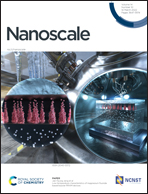Ca2+ accelerates peptide fibrillogenesis via a heterogeneous secondary nucleation pathway†
Abstract
A binding-induced fibrillogenesis (BIF) peptide mimics the fibrillogenesis of fibronectin, forming fibrous networks for disease theranostics. However, the mechanism of fast fibrillogenesis of the BIF peptide remains unclear. In this study, the fibrillogenesis processes of the BIF peptide in the absence and presence of receptors, i.e. Ca2+, are carefully studied. The BIF peptide, lauric acid-FFVLK-HSDVHK (LAFH) can self-assemble into nanoparticles (NPs) in solution and further transform into a fibrous structure, the fibrillogenesis of which could be accelerated by the addition of Ca2+. In detail, the fibrillogenesis of LAFH NPs without Ca2+ is achieved through a nucleation-elongation mechanism, in which homogeneous secondary nucleation is involved, followed by detachment of the newly formed fibers from pre-formed nanofibers (NFs). The fibrillogenesis of LAFH NPs in the presence of Ca2+ starts with an Ostwald ripening process, followed by a heterogeneous secondary nucleation, in which LAFH NPs bind to pre-formed LAFH NFs via Ca2+. The phenomenon of heterogeneous secondary nucleation including the attachment and shape change of LAFH NPs on pre-formed LAFH NFs is first revealed by TEM observation. These findings contribute to the understanding of the fast BIF process, supporting the mechanism study at the cellular level.



 Please wait while we load your content...
Please wait while we load your content...